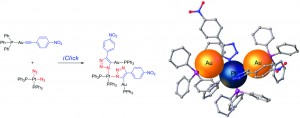Posted on behalf of Ian Mallov, web writer for Dalton Transactions
When you hear the phrase “at the click of a button” you expect that something can be done both simply and efficiently. Likewise, the original aim of Click Chemistry as stated by Nobel laureate K. Barry Sharpless in 2001 was to develop simple, efficient chemical reactions that would yield a wide range of new molecules to be tested for applications in pharmaceuticals or materials.
The particular type of reaction most often associated with Click Chemistry is the azide/alkyne cycloaddition, wherein a molecule containing a carbon-carbon triple bond is reacted with a molecule containing a terminal (azide) group of three nitrogen atoms such that they join together resulting in a five-membered “triazolate” heterocycle incorporating the two carbon and three nitrogen atoms.
Over the past twelve years chemists have developed a diverse range of molecules that feature these two functional groups and thus can be combined using this reaction. The variation on this chemistry presented here by the group of Adam S. Veige includes gold and platinum metal atoms in the starting molecules. The grand goal, they state, would be to use this reaction to synthesize perfectly regular polymers incorporating metal atoms linked by the triazolate bridges for possible use in materials.
Impressively, they synthesize in high yield a molecule featuring a gold-platinum-gold motif where the gold and platinum atoms are indeed linked by triazolate bridges using this reaction. They also present other less high-yielding, but nonetheless interesting reactions, including one wherein they link the two gold atoms within a very similar molecule using a bis(diphenylphosphino)methane bridge, forcing the two gold atoms to bend symmetrically to the same side of the molecular plane.
To sum up with an alliteration, such manipulations of multi-metallic molecules may move masterfully towards many materials.
Find out more from the paper:
Inorganic click (iClick) synthesis of heterotrinuclear PtII/AuI2 complexes
Andrew R Powers, Xi Yang, Trevor J del Castillo, Ion Ghiviriga, Khalil A Abboud and Adam Steven Veige
Dalton Trans., 2013, Accepted Manuscript
DOI: 10.1039/C3DT52105B, Communication
 Ian Mallov is currently a Ph.D. student in Professor Doug Stephan’s group at the University of Toronto. His research is focused on synthesizing new Lewis-acidic compounds active in Frustrated Lewis Pair chemistry. He grew up in Truro, Nova Scotia and graduated from Dalhousie University and the University of Ottawa, and worked in chemical analysis in industry for three years before returning to grad school.
Ian Mallov is currently a Ph.D. student in Professor Doug Stephan’s group at the University of Toronto. His research is focused on synthesizing new Lewis-acidic compounds active in Frustrated Lewis Pair chemistry. He grew up in Truro, Nova Scotia and graduated from Dalhousie University and the University of Ottawa, and worked in chemical analysis in industry for three years before returning to grad school.











